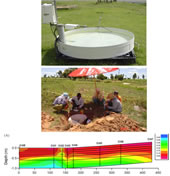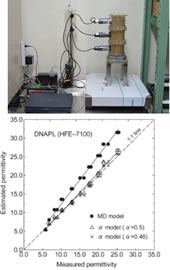Research Area : Irrigation and Drainage
Study on evapotranspiration and soil water content for water resources
Evapotranspiration and soil water content are very important as key factors of hydrologic cycle and water resources. In our laboratory, the following two researches on evapotranspiration and soil water are carried out: (1) There are some methods for estimating the evapotranspiration, it, however, is not so convenient to use those methods because they often needs the meteorological data at two heights. We aim to develop the simple method for estimating evapotranspiration using one heig ht meteorological data. (2) We estimate the potential water resources for agricultural products using soil water content, evapotranspiration, and other data.
The results of these researches would be contribute to not only agriculture and irri gation but also the recent variation of hydrologic cycle.

Developing a technique for estimating soil and groundwater contamination utilizing permittivity, thermal properties, and other physical properties

Soil and groundwater contamination by NAPLs (nonaqueous-phase liquids) has become a serious environmental issue in Japan and around the world. It is difficult to detect or monitor the transport rates of NAPLs under field conditions, because the NAPLs are immiscible with water. In addition, because chemical solutions are often mixed with NAPLs, the detection of contaminant is more complicated. In our laboratory, we aim to develop the fundamental techniques to detect the soil and groundwater contaminated with both NAPLs and chemical solutions using some physical properties such as permittivity, thermal properties, and self – potential.
Study on balancing agricultural practices with nature to protect water resources
Agriculture is essential to modern civilization but often has unintended negative effects upon the natural environment, especially regarding water quality. Overuse of fertilizers is costly both economically and environmentally. We evaluated regional agricultural cultivation practices to determine optimal irrigation and fertilizer, timing and amounts, to maximize production while minimizing nutrient-driven eutrophication of local water bodies.
Agricultural fields are used not only by farmers, but also by wildlife. We studied the effects of the Tundra Swan on nutrient levels in rice paddies. Tundra Swans, from Far East Russia, overwinter in flooded paddy-fields from November to March. They roost in the paddy-fields at night and forage nearby in other agricultural fields during the day. We measured Tundra Swan manure-nutrient component of paddy-field soil and water nutrient concentrations to determine optimal farmer-applied fertilizer amendments required for rice production, without over-applying.
Our ultimate goal is to find a win-win-win relationship among the environment, humans (farmers), and wildlife with respect to water quality.

Study on irrigation management for stabilizing agricultural production
Water is critical for agriculture and irrigation practice is an important part of farm management. Irrigation water is often wasted or poorly applied (i.e., amount or timing) leading to lowered agricultural production from poor crop health or damage. It is important to evaluate water resource availability to effectively manage irrigation timing and amounts required for efficient crop production.
We assessed watershed-level water availability upon a local irrigation scheme. Data were gathered through field observations and farmer questionnaires. Data were evaluated by computer modeling. At the watershed level, irrigation water allocation is spatially unbalanced among upstream, midstream, and downstream observations. We attempted to determine alternative management methods and/or improve current methods for efficiently allocating irrigation water equally to the fields.
By improving irrigation water use efficiency through better allocation management, there is an apparent increase in water availability. This will lead to an expanded cultivation area, higher production, and ultimately, better agricultural stability.





